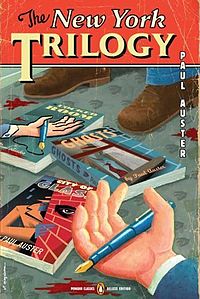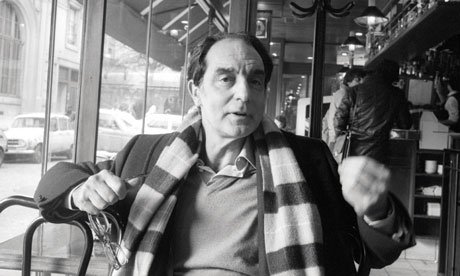Happy New Year’s Eve, world! I won’t be like everyone and say, “I can’t believe how fast this year went by,” so I’ll just say, “I can’t believe how slowly this year went by.” We get 365 days and I only managed to read a handful of books! Here’s to a fuller 2014 with more books and more book reviews! For now, it’s time to wrap up the year by reflecting on the important things. Here is my list of the top ten books I read and reviewed this year with excerpts from and links to my reviews on each of them! Enjoy, and thanks to all my followers, casual readers, friends, and family for helping me enjoy myself with this little, whimsical blog.
The Top Ten of 2013

To Be or Not To Be was a smashing success on Kickstarter. Now Ryan North is working on another Shakespeare-Choosable Adventure mash-up featuring none other than Romeo and Juliet.
10. To Be or Not To Be by Ryan North
Welcome to the chooseable-path review of Ryan North’s new chooseable-path adventure, To Be or Not To Be, which hilariously takes one of William Shakespeare’s greatest tragedies and recreates it as a humorous, illustrated, maybe-but-maybe-not tragedy! North joins with dozens of the internet’s best/most popular Web comic artists to gamify Hamlet: “play” as Ophelia, Hamlet, or King Hamlet Sr., make choices throughout the book, and see where your will can take your character! This was originally a Kickstarter project that set the bar at a low $20,000 goal, but its novelty and the inclusion of some heavy-weight names (plus, who isn’t interested in Shakespeare …? No, really, who isn’t? Because I’m going to give you a scolding), catapulted the book to a lofty $580,905. Although it’s too late to donate to the project, you should still check out the site to see what it took to get this thing off the ground. …

My first experience with James Baldwin was filled with sighs and my own broken heart. Giovanni’s Room takes the win for saddest book of the year.
9. Giovanni’s Room by James Baldwin
How does one even begin to talk about Giovanni? I’m so overwhelmed still, and I can confidently say, that Giovanni’s Room is my favorite book of 2013 so far … maybe. This novel speaks to James Baldwin’s ever-present awareness of his foreignness, his separateness, his Otherness. Giovanni’s Room is one of the truest most tragic novels I’ve read in a long time because it speaks to my sense of Otherness, too. …

Neal Stephenson tackled massive multiplayer online role-playing games AND terrorism in Reamde. What more do you want?
8. Reamde by Neal Stephenson
Richard Forthrast—the billionaire, draft-dodger, former drug-runner, T’Rain founder—and his niece Zula find themselves invited to a figurative party of Chinese hackers, Russian mobsters, ex-military rogues, MI6 agents, and Islamic terrorists (obviously) that even Gatsby would envy, it’s so elaborate and wrought with confusion and angst. The plot that began with relatively simple, moneymaking scheme/computer virus becomes frightening and life threatening. But isn’t that how it always goes? …

Italo Calvino wrote a lot of letters in his relatively short life, and many of them are collected here in Princeton University Press’ Letters.
7. Italo Calvino: Letters, 1941-1985 by Italo Calvino
The bizarre thing about reading other people’s letters, is you get to thinking that they’re writing letters to you… Then you start developing some kind of strange celebrity obsession with those people, maybe more like an infatuation, or maybe like True Love. Not saying that happened to me or anything! But with Italo Calvino: Letters 1941-1985, it’s hard not to fall in love (or fall in respect, whatever) with this magnificent writer, Italy’s premier postmodern author, and one of my personal favorites. …

Forged in Fire by J.A. Pitts is the third installation of the Sarah Beauhall series, and arguably the best (so far). Make sure you start reading from the beginning.
6. Forged in Fire by J.A. Pitts
I think, at this point, I can officially classify myself as a Sarah Beauhall fangirl. When I saw the series as Powell’s for the first time, I decided I’d read it on a whim, not expecting anything more than brief entertainment or maybe something to write a scathing review on later. Lo and behold! I have to take back those thoughts of an unbeliever! Forged in Fire is J.A. Pitts’s third Sarah Beauhall installation, and I had more fun than ever. Pitts created a cast of full characters and a massive enough world to keep this series going strongly as Sarah Beauhall uncovers more dark magic, learns about a new secret order, and forms some important human bonds that help her understand the meaning of family. …

As troubling as it is genius, The Handmaid’s Tale is a cautionary novel written in Margaret Atwood’s iconic prose.
5. The Handmaid’s Tale by Margaret Atwood
I finally read Margaret Atwood’s dazzling The Handmaid’s Tale and got a bitter taste of how scary religion can be. From my comfy seat in America, looking through my blinders out at the world, I can safely say I feel pretty free in comparison, and that other religions (*ahem* Islam) have gotten a little out of control. But Atwood’s beautiful novel is more like a slap in the face: America, already a so-called Christian nation, is short skip and a hop away from a society mirroring modern-day Iran’s or Afghanistan’s, a society that forbids the interaction between men and women, that “shelters” women with thick cloth and heavy restrictions for their “protection” and “purity,” that uses indoctrination and propaganda to destroy hope, to remove all routes of escape. Atwood’s dystopia is, in the end, much more frightening then the dystopias I grew up with—1984 and Brave New World—because it’s infinitely more possible. …

Do you love mysteries? Do you not love mysteries? Either way, start your 2014 with quality reading and pick up Paul Auster’s The New York Trilogy.
4. The New York Trilogy by Paul Auster
It’s never more apparent how brilliant Paul Auster is when you start reading him just after you have finished a mediocre novel. The New York Trilogy is one of Auster’s most renowned works of fiction, and–you guessed correctly!–it’s actually three separate novels. In New York, where all magical things happen, several mysteries are being investigated by several characters, some metaphysical shit goes down, people talk a lot about people talking or not talking, excuse me, my name is Peter Stillman. But all that aside, TNYT is a mystery of mysteries. It is the meta-mystery. It transcends. Best to read it while either completely high or sleep deprived.
3. The Devil in the White City by David Larson
This is the story of two architects, tested on the sooty, soiled grounds of late-19th Century Chicago: Daniel Burnham, an architect of buildings in the age of steel and the director of works of the great World’s Columbian Exposition of 1893; and H.H. Holmes, an architect of manipulation, murder, and the macabre who killed dozens of people while staying hidden from the police, just blocks away from the fair’s entrances–both were equally ambitious and worked incessantly toward their respective goals. At the World’s Fair, they represented the city’s two faces: the White City and the hell hole, the symbol of hope and the harbinger of horror. …

John Fowles’s first novel The Collector blew everyone out of the water. I myself have been out of the water since I read it in April this year.
2. The Collector by John Fowles
John Fowles’s debut novel certainly set the bar high. I felt the need to start by reading this book because it seemed to suit me (or suit my obsession with Law & Order: SVU, CSI, andCriminal Minds; a girl can’t have too much crime TV), and I stand by my choice. The Collector follows Frederick Clegg in his project to stalk, kidnap, and woo the object of his affections, Miranda Grey, a young art student of the upper middle class. If Clegg were a young gallant knight or the Earl of Rochester, this story could be romantic, or at the very least, kind of kinky. But Clegg is a loner, a man with little to no social graces who happens to really, really like collecting butterflies, so the story has to go the creepy rout. Fine by me, since Fowles can definitely pull off creepy and pull it off well. …
And the winner of the LitBeetle’s Pick of the 2013 is …

Gone Girl is the 2012 thriller by Gillian Flynn and tells the story of Nick Dunne, under suspicion of killing his wife Amy.
1. Gone Girl by Gillian Flynn
I came to this book without expectations. It seems everyone but I had heard of it and already added it to their Goodreads “Want to Read” bookshelf, but it’s all in character for me, so I shouldn’t be surprised. That being said, I only got to page 16 before I decided I loved this book. Gillian (like my name, so we’re practically twins!) Flynn’s Gone Girl is a perfect specimen for a morbid curiosity. The girl in question is Amy Elliott Dunne, the supposed victim in a missing person’s case. Her husband Lance Nicholas “Nick” Dunne is the supposed perpetrator (because it’s always the husband, right?). Amy and Nick are beautiful, successful, clever, and bursting with love for each other, but when both are laid off, the initial spark of their marriage dies out, and a family crisis uproots them from their beloved Manhattan and lands them in Nick’s rural Missouri hometown of North Carthage, the two are embroiled in a battle of wit, sadism, and manipulation. You won’t be able to tear your eyes away from this train wreck, and you may think you can predict the outcome (and maybe you’re better at that than I am), but you will enjoy the unfolding of this disastrous relationship the whole time. …
A special runner up mention goes to …

A Memory of Light is the final installation of Robert Jordan’s beloved fantasy series Wheel of Time.
A Memory of Light by Robert Jordan and Brandon Sanderson
So I didn’t technically review this book, but I spent the better part of the first quarter of 2013 rereading Robert Jordan’s modern classic fantasy series The Wheel of Time, which culminated in this joint effort with author Brandon Sanderson. A Memory of Light ended a fourteen-book series and what was, for a lot of fantasy readers, an era of genre bliss. The Wheel of Time was my escapism from the minor horrors of high school, and A Memory of Light was a fitting end.
It would be a mistake to say I’m not obsessed with morbid mystery novels. I am. Just going to come right out and say it. Gillian Flynn’s novel goes above and beyond, taking morbidity to high entertainment. I won’t say Gone Girl is great “Literature,” but I enjoyed it the most out of all the books I read this year, and I think it will stand up to the test of time.
I can’t wait to read another several dozen books next year! Thanks, again, to all my followers who tagged along with me on my silly adventures through literature (and not-literature)! Send me book recommendations and help me make 2014 a more exciting year for books than 2013!
The Complete List
The Fires of Heaven by Robert Jordan
Lord of Chaos by Robert Jordan
A Crown of Swords by Robert Jordan
The Path of Daggers by Robert Jordan
Winter’s Heart by Robert Jordan
Crossroads of Twilight by Robert Jordan
Knife of Dreams by Robert Jordan
The Gathering Storm by Robert Jordan
Towers of Midnight by Robert Jordan
A Memory of Light by Robert Jordan
Hikikomori and the Rental Sister by Jeff Backhaus
A Spy in the Ruins by Christopher Bernard
The Collector by John Fowles
The Handmaid’s Tale by Margaret Atwood
Reamde by Neal Stephenson
The Forever War by Joe Haldeman
The Hours by Michael Cunningham
The Snowman by Jo Nesbo
Invisible Cities by Italo Calvino
American Gods by Neil Gaiman
Ganymede by Cherie Priest
The Poisoned Chocolates Case by Anthony Berkeley
The Inspector and Silence by Hakan Nesser
Giovanni’s Room by James Baldwin
The Woman Upstairs by Claire Messud
Black Blade Blues by J.A. Pitts
The Devil in the White City by Erik Larson
To Be or Not To Be by Ryan North (and Shakespeare)
The Catcher in the Rye by J.D. Salinger
Vurt by Jeff Noon
Heir to the Empire by Timothy Zahn
Italo Calvino: Letters 1941-1985 by Italo Calvino
The Lifted Veil by George Eliot
The Stranger by Albert Camus
We Have Always Lived in the Castle by Shirley Jackson
Honeyed Words by J.A. Pitts
A Lifetime by Morris Fenris
Underground by Haruki Murakami
The Death of Ivan Ilych by Leo Tolstoy
Nightlight by The Harvard Lampoon
Forged in Fire by J.A. Pitts
Bleeding Edge by Thomas Pynchon
The Wrecking Yard by Pinckney Benedict
A Sudden Wild Magic by Diana Wynne Jones
Ceremony by Leslie Marmon Silko
The View from Castle Rock by Alice Munro
A Thousand Perfect Things by Kay Kenyon
Gone Girl by Gillian Flynn
The Fall of the Stone City by Ismail Kadare
American Psycho by Bret Easton Ellis
The Cuckoo’s Calling by Robert Galbraith (aka J.K. Rowling)
The Golden Compass by Philip Pullman
Paprika by Yasutaka Tsutsui
City of Glass by Paul Auster
Ghosts by Paul Auster
The Locked Room by Paul Auster
Suicide Game by Haidji
Starship Troopers by Robert A. Heinlein
Tags: 2013, A Memory of Light, Brandon Sanderson, City of Glass, Erik Larson, Fantasy, fiction, Forged in Fire, Ghosts, Gillian Flynn, Giovanni's Room, Gone Girl, Italo Calvino, Italo: Calvino: Letters 1941-1985, J.A. Pitts, James Baldwin, John Fowles, Letters, Literature, Margaret Atwood, Mystery, Neal Stephenson, Novels, Paul Auster, Princeton University Press, Reamde, Robert Jordan, Ryan North, Sci-Fi, The Collector, The Devil in the White City, The Handmaid's Tale, The Locked Room, The New York Trilogy, To Be or Not To Be, Top Ten, Wheel of Time






















